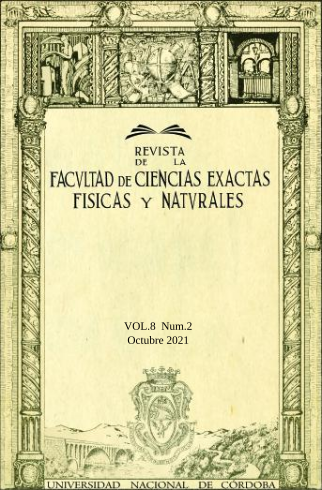Variation of water quality from Chicamtoltina stream through two localities
Keywords:
Water quality index, Chicamtoltina stream, ionic compositionAbstract
The Chicamtoltina stream has a length of 13 km from its source in the city of Alta Gracia to the mouth of the river Anisacate in the town of the same name. Along its length, it receives various sources that vary in quality, such as effluents from the wastewater treatment plant (WWTP) downstream of the city of Alta Gracia. The Canadian Council of Ministers of the Environment (CCME WQI) Water Quality Index (WQI) was applied to evaluate the variation in water quality of the stream along its course, considering its landscape importance and recreational use. At the same time, a study of ionic composition was carried out to evaluate the differences that the different sources flowing into the stream can mean. The results show that the stream has an autodepuration capacity, showing the stabilization of the organic material indicators (BOD and DO) but the recuperation of the sanitary aspects is not enough (high leves of Escherichia coli ). The ionic composition shows a change in the ionic state of its waters, going from a calcareous and bicarbonate-type state to a more alkaline state.
Downloads
References
[1] American Public Health Association, American Water Works Association, Water Environment Federation (2012), Estados Unidos, “Standard Methods for the Examination of Water and Wastewater”.
[2] Canadian Council of Ministers of the Environment (CCME)(2001). Canadian water quality guidelines for the protection of aquatic life: CCME Water Quality Index 1.0, User’s Manual. In: Canadian environmental quality guidelines, 1999, Canadian Council of Ministers of the Environment, Winnipeg.
[3] Daziano, C. (2011). Hidroquímica y aptitud de aguas superficiales Alta Gracia -Córdoba Argentina. Córdoba, Argentina [Recuperado de https://pdfs.semanticscholar.org/71c6/14a427323b2c790cd34eb8de38db59a611b5.pdf el 13 de mayo de 2020]
[4] Li S., Xu Z., Wang H., Wang J. y Zhang Q. (2009). Geo-chemistry of the upper Han River basin, China. 3: Antropogenic inputs and chemical weathering to the dissolved load. Chem. Geol. 264, 89-95.
[5] Meybeck M (2005) Global occurrence of major elements in rivers. In: Drever JI (ed) Surface and ground water, weathering and soils, vol 5. (In: Holland HD, Turekian KK (eds) Treatise of Treatise of geochemistry, 1st edn.). Elsevier-Pergamon, Oxford, pp 207–223
[6] Neal C., Jarvie H., Love A., Neal M., Wickham H. y Har¬man S. (2008). Water quality along a river continuum subject to point and diffuse sources. J. Hydrol. 350, 154-165.
[7] Pasquini A.I., Formica S.M. y Sacchi G.A. (2012). Hydro-chemistry and nutrients dynamic in the Suquía River urban catchment’s, Córdoba, Argentina. Environ. Earth Sci. 65, 453-467.
[8] Sutadian, A. D., Muttil, N., Yilmaz, A. G., y Perera, B. J. C. (2015). Development of river water quality indices—a review. Environmental Monitoring and Assessment, 188(1). doi:10.1007/s10661-015-5050-0
Downloads
Published
Issue
Section
License
Copyright (c) 2021 Facultad de Ciencias Exactas, Físicas y Naturales (Universidad Nacional de Córdoba)

This work is licensed under a Creative Commons Attribution 4.0 International License.
Los autores que publican en esta revista están de acuerdo con los siguientes términos:
Los autores conservan los derechos de autor y conceden a la revista el derecho de la primera publicación.
Los autores pueden establecer por separado acuerdos adicionales para la distribución no exclusiva de la versión de la obra publicada en la revista (por ejemplo, situarlo en un repositorio institucional o publicarlo en un libro), con un reconocimiento de su publicación inicial en esta revista.
Se permite y se anima a los autores a difundir sus trabajos electrónicamente (por ejemplo, en repositorios institucionales o en su propio sitio web) antes y durante el proceso de envío, ya que puede dar lugar a intercambios productivos, así como a una citación más temprana y mayor de los trabajos publicados (Véase The Effect of Open Access) (en inglés).



